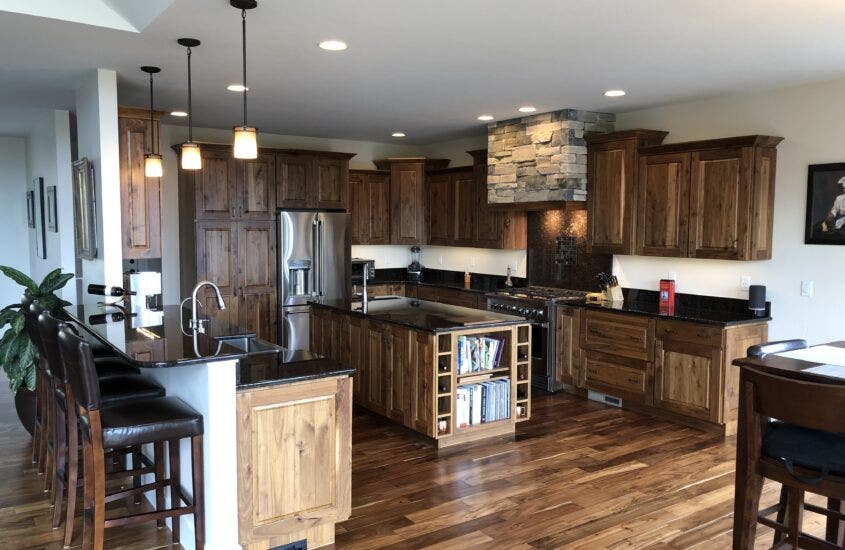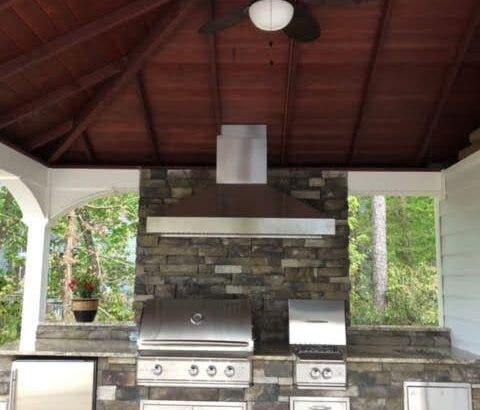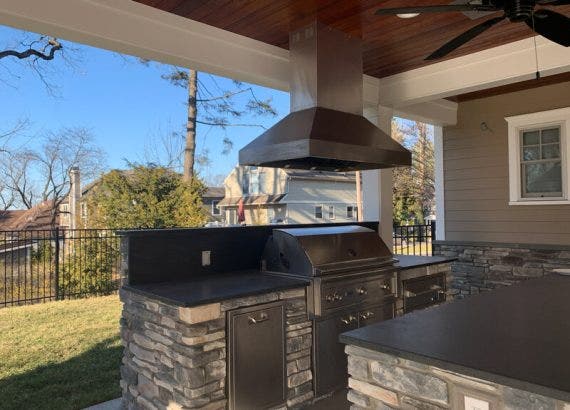How Many Sones Is My Range Hood? – Sones to dB Conversion

Range hoods typically produce between three and seven sones depending on their power, as measured in cubic feet per minute or CFM. But what does that mean in decibels?
While design, size, and power are all important, an overlooked aspect of your hood is noise level. Some hoods are loud. Loud hoods can be disruptive and may not be ideal if you plan to host guests often at your home.
When installing a vent hood in your home, you’ll probably want a quieter hood. Your friends and family can then enjoy the comfort of your kitchen and socialize. Yet sometimes, louder vent hoods are necessary because you need more power to vent cooking exhaust out of your kitchen.
Keep reading for more information on sone level and be sure to check out the video below.
Table of Contents
What is a sone and how is it measured?
A sone, named by Stanley Smith Stevens in 1936, is an internationally recognized unit of measurement for loudness. Stevens was a psychologist and researcher who founded Harvard’s Psycho-Acoustic Laboratory.
This unit provides accurate information on the amount of sound the blower produces inside the vent hood.
Sones are measured on a linear scale, like inches or centimeters. As a linear measurement, doubling the sone level is equivalent to doubling the loudness; quadrupling the sone value quadruples the loudness, etc.
In contrast, decibels are measured on a logarithmic scale. For example, about a 10 dB increase doubles loudness.
Both sones and decibels are measurements of sound pressure. To compare decibel levels with sones, check out this helpful chart below.
Sones to decibels Conversion Chart – How many decibels are in a sone?
Here is a helpful equation to convert sones to decibels:
dB = 33.2*log10(Sones) + 28
To find how many decibels are in one sone, plug one into the equation:
dB = 33.2*log10(1) + 28 = 28 dB
If you have decibels and want to find the number of sones, use this equation:
Sones = 10((db-28)/33.2)
These equations may look daunting which is why we made calculation easy for you. Check out the table below which has sones to decibel conversions up to 20 sones.
| Sones | Decibels |
|---|---|
| 1 | 28 |
| 2 | 37.99 |
| 3 | 43.84 |
| 4 | 47.99 |
| 5 | 51.21 |
| 6 | 53.83 |
| 7 | 56.06 |
| 8 | 57.98 |
| 9 | 59.68 |
| 10 | 61.2 |
| 11 | 62.57 |
| 12 | 63.83 |
| 13 | 64.98 |
| 14 | 66.05 |
| 15 | 67.05 |
| 16 | 67.98 |
| 17 | 68.85 |
| 18 | 69.68 |
| 19 | 70.45 |
| 20 | 71.19 |
To summarize this decibels chart, one sone is 28 dB and eight sones are about 57 dB. This is roughly the appropriate range of sound level for your range hood.
One sone is similar to a whisper or the sound of an extremely quiet refrigerator or dishwasher. Eight sones are equivalent to a normal conversation or background noise.
The lower the sone value, the quieter the hood. Sone levels are lowest when your hood is set to the lowest speed and get louder incrementally with each speed.
How are sones and CFM related?
Typically, sones are measured at maximum hood speed or CFM. So, for example, when buying a range hood that runs at six sones, six is the maximum noise level that the range hood will produce.
We recommend the following: first, think about the max amount of noise that you would be comfortable with. Then, buy a hood based on that measurement.
In most cases, the higher the CFM, the higher the sone level of the range hood. So, if you want a quieter hood and don’t cook often, purchase a 600 CFM range hood.
However, if you cook a lot of greasy, fried, or Asian food – or simply cook often – invest in a 900+ CFM range hood. It will be louder than low-CFM hoods, but it will have more power too, which is ideal to clean your kitchen air efficiently.
When you want to cook lower-heat food, you can go with one of the quiet settings. You can also change the position of your blower to enjoy a comfortably quiet kitchen.
There are three types of blowers: local, remote, and external. An external or remote blower is the best option to reduce the sound level of your kitchen fan. External blowers are separate from the hood entirely, installed outside your home to drastically reduce the sound level. These are not common and they are more expensive than local or remote blowers.
Remote blowers, also called inline blowers, work well, as these motors are installed within your chimney. They are further away from the front of the hood than local blowers, which are installed inside your hood. This keeps the sound produced from your blower at bay.
Keep in mind that your hood won’t be on max speed all the time; typically, it will only run on max speed when you have a lot of smoke which needs to be cleared out of the room fast.
How loud is six sones?
Six sones are about equivalent to the noise level of an electric fan.
How many sones is a quiet range hood?
At max power, a quiet range hood is between four and five sones. With a variable speed hood, you can enjoy an even quieter fan, all the way down to 1 sone.
Browse our quiet range hoods at the banner below, which have a max sone level of just 4.5.
Is 65 dB loud for a range hood?
65 dB is unusually loud for a range hood. From the dB conversion chart above, 65 dB is about 13 sones, while most vent hoods are between 6 to 8 sones.
What is the sound pressure level?
The sound pressure level is simply another way to describe decibels.
Sound is emitted in soundwaves. Each soundwave, depending on its intensity, changes the atmospheric pressure of the surrounding area.
The most common measurement for sound pressure is decibels, but it can also be measured in sones.
Note on the Threshold of Hearing
The threshold of human hearing, also called the auditory threshold, is widely accepted to be 0 dB. This is the quietest sound that a human ear can register.
For reference, 1 sone is much louder than 0 dB, at 28 dB, according to the sones to dba chart. So, kitchen hood loudness is far from this hearing threshold, but there’s no danger of hearing damage or hearing loss. The maximum sound level of your vent hood is not very loud: the sound of traffic noise.
The general consensus of safe decibel levels for the human ear is 70 dB or below. Consistent exposure to 85 dB and above may result in hearing damage or hearing loss.
Hopefully, this guide gives you the tools to determine the loudness of your range hood.
Good luck finding the right vent hood for you! Call us at (877) 901 – 5530 or email us at support@prolinerangehoods.com if you have any questions.
Related Articles
What is a sone and how does it apply to vent hoods?
How many CFM Do I Need For My Vent Hood?
Range Hood CFM for Electric vs. Gas Cooktops
What is a sone and how is it measured?
A sone, named by Stanley Smith Stevens in 1936, is an internationally recognized unit of measurement for loudness. Stevens was a psychologist and researcher who founded Harvard’s Psycho-Acoustic Laboratory.
This unit provides accurate information on the amount of sound the blower produces inside the vent hood.
Sones are measured on a linear scale, like inches or centimeters. As a linear measurement, doubling the sone level is equivalent to doubling the loudness; quadrupling the sone value quadruples the loudness, etc.
In contrast, decibels are measured on a logarithmic scale. For example, about a 10 dB increase doubles loudness.
Both sones and decibels are measurements of sound pressure. To compare decibel levels with sones, check out this helpful chart below.
How are sones and CFM related?
Typically, sones are measured at maximum hood speed or CFM. So, for example, when buying a range hood that runs at six sones, six is the maximum noise level that the range hood will produce.
We recommend the following: first, think about the max amount of noise that you would be comfortable with. Then, buy a hood based on that measurement.
In most cases, the higher the CFM, the higher the sone level of the range hood. So, if you want a quieter hood and don’t cook often, purchase a 600 CFM range hood.
However, if you cook a lot of greasy, fried, or Asian food – or simply cook often – invest in a 900+ CFM range hood. It will be louder than low-CFM hoods, but it will have more power too, which is ideal to clean your kitchen air efficiently.
How loud is six sones?
Six sones are about equivalent to the noise level of an electric fan.
How many sones is a quiet range hood?
At max power, a quiet range hood is between four and five sones. With a variable speed hood, you can enjoy an even quieter fan, all the way down to 1 sone.
Browse our quiet range hoods at the banner below, which have a max sone level of just 4.5.
Is 65 dB loud for a range hood?
65 dB is unusually loud for a range hood. From the dB conversion chart above, 65 dB is about 13 sones, while most vent hoods are between 6 to 8 sones.
What is the sound pressure level?
The sound pressure level is simply another way to describe decibels.
Sound is emitted in soundwaves. Each soundwave, depending on its intensity, changes the atmospheric pressure of the surrounding area.
The most common measurement for sound pressure is decibels, but it can also be measured in sones.







Comments are closed.